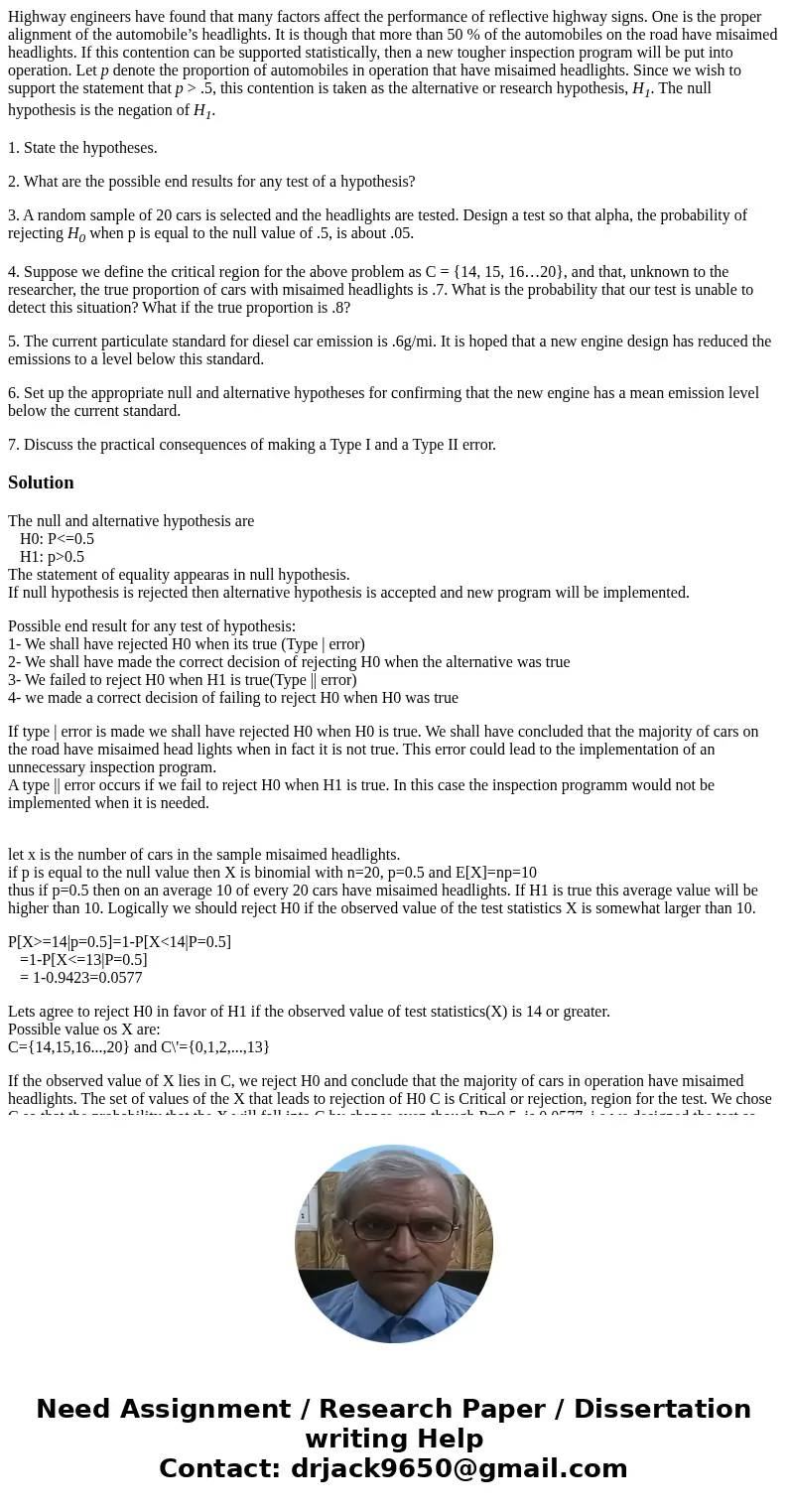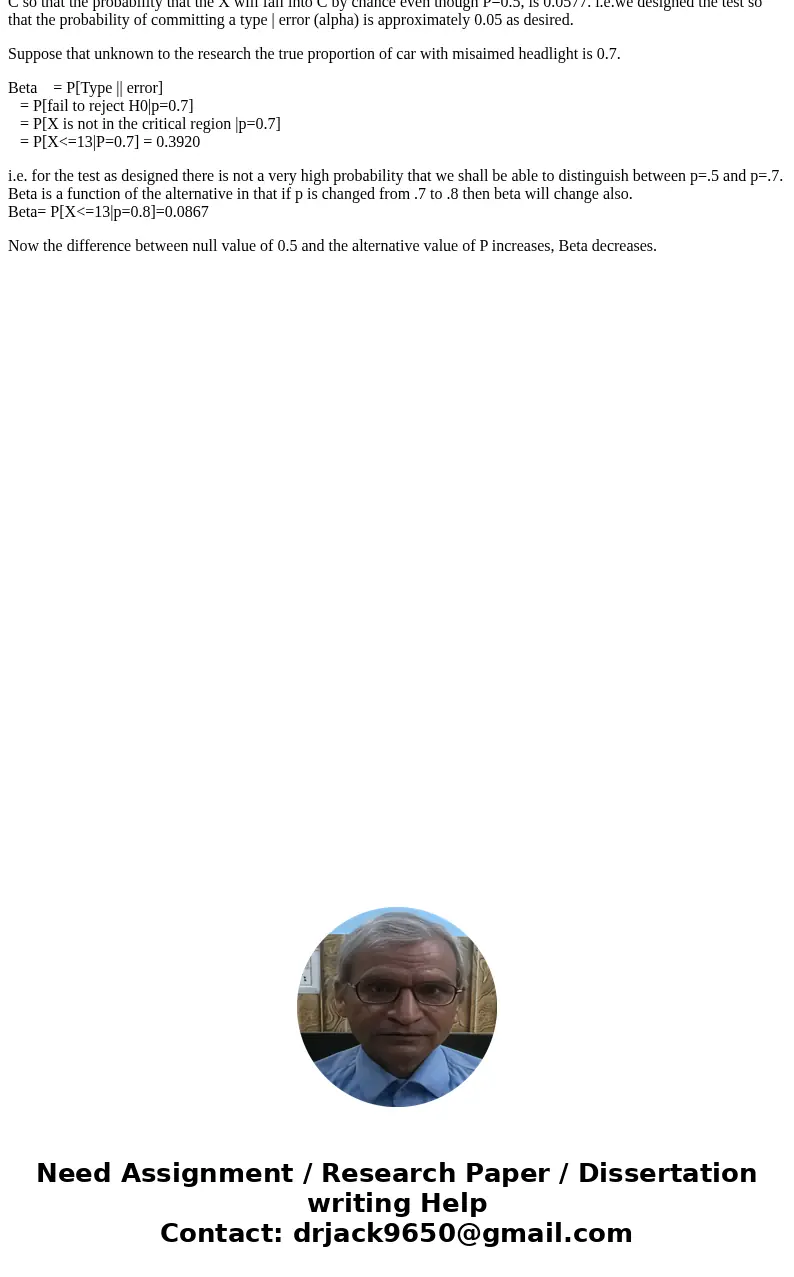Highway engineers have found that many factors affect the pe
Highway engineers have found that many factors affect the performance of reflective highway signs. One is the proper alignment of the automobile’s headlights. It is though that more than 50 % of the automobiles on the road have misaimed headlights. If this contention can be supported statistically, then a new tougher inspection program will be put into operation. Let p denote the proportion of automobiles in operation that have misaimed headlights. Since we wish to support the statement that p > .5, this contention is taken as the alternative or research hypothesis, H1. The null hypothesis is the negation of H1.
1. State the hypotheses.
2. What are the possible end results for any test of a hypothesis?
3. A random sample of 20 cars is selected and the headlights are tested. Design a test so that alpha, the probability of rejecting H0 when p is equal to the null value of .5, is about .05.
4. Suppose we define the critical region for the above problem as C = {14, 15, 16…20}, and that, unknown to the researcher, the true proportion of cars with misaimed headlights is .7. What is the probability that our test is unable to detect this situation? What if the true proportion is .8?
5. The current particulate standard for diesel car emission is .6g/mi. It is hoped that a new engine design has reduced the emissions to a level below this standard.
6. Set up the appropriate null and alternative hypotheses for confirming that the new engine has a mean emission level below the current standard.
7. Discuss the practical consequences of making a Type I and a Type II error.
Solution
The null and alternative hypothesis are
H0: P<=0.5
H1: p>0.5
The statement of equality appearas in null hypothesis.
If null hypothesis is rejected then alternative hypothesis is accepted and new program will be implemented.
Possible end result for any test of hypothesis:
1- We shall have rejected H0 when its true (Type | error)
2- We shall have made the correct decision of rejecting H0 when the alternative was true
3- We failed to reject H0 when H1 is true(Type || error)
4- we made a correct decision of failing to reject H0 when H0 was true
If type | error is made we shall have rejected H0 when H0 is true. We shall have concluded that the majority of cars on the road have misaimed head lights when in fact it is not true. This error could lead to the implementation of an unnecessary inspection program.
A type || error occurs if we fail to reject H0 when H1 is true. In this case the inspection programm would not be implemented when it is needed.
let x is the number of cars in the sample misaimed headlights.
if p is equal to the null value then X is binomial with n=20, p=0.5 and E[X]=np=10
thus if p=0.5 then on an average 10 of every 20 cars have misaimed headlights. If H1 is true this average value will be higher than 10. Logically we should reject H0 if the observed value of the test statistics X is somewhat larger than 10.
P[X>=14|p=0.5]=1-P[X<14|P=0.5]
=1-P[X<=13|P=0.5]
= 1-0.9423=0.0577
Lets agree to reject H0 in favor of H1 if the observed value of test statistics(X) is 14 or greater.
Possible value os X are:
C={14,15,16...,20} and C\'={0,1,2,...,13}
If the observed value of X lies in C, we reject H0 and conclude that the majority of cars in operation have misaimed headlights. The set of values of the X that leads to rejection of H0 C is Critical or rejection, region for the test. We chose C so that the probability that the X will fall into C by chance even though P=0.5, is 0.0577. i.e.we designed the test so that the probability of committing a type | error (alpha) is approximately 0.05 as desired.
Suppose that unknown to the research the true proportion of car with misaimed headlight is 0.7.
Beta = P[Type || error]
= P[fail to reject H0|p=0.7]
= P[X is not in the critical region |p=0.7]
= P[X<=13|P=0.7] = 0.3920
i.e. for the test as designed there is not a very high probability that we shall be able to distinguish between p=.5 and p=.7. Beta is a function of the alternative in that if p is changed from .7 to .8 then beta will change also.
Beta= P[X<=13|p=0.8]=0.0867
Now the difference between null value of 0.5 and the alternative value of P increases, Beta decreases.


 Homework Sourse
Homework Sourse